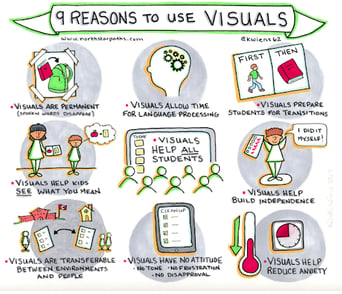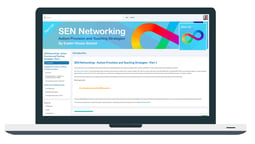It's not what you do, it's how you do it...
As head of teaching, learning and professional development in a special school, I consider myself to be very fortunate in the experiences I have gained; not only do I get to work alongside a group of truly expert and inspirational teachers every day, I also get opportunities to network with some great people who have further helped to shape and guide my own practices. Throughout the years, one aspect of teaching has continued to shine through: that teaching is teaching. It is not the amount of years of experience or leadership one has, nor is it the setting in which you teach. The most prevailing aspect is that good teaching can be universal – ‘good teaching for pupils with SEND is good teaching for all’. (EEF)
I often find myself wondering how many times educators have come across this phrase “I tried that before and it didn’t work”, particularly when supporting students with special educational needs. This resonating question has led me to delve in deeper, to look further into what ‘good practice’ means in the context of SEN and how we can turn ‘good’ into ‘excellent’.
My passion has always been in helping others and I hope that through unpicking good practices seen in SEN provision, I can help and provide you with practical applications to use in all classroom environments, with all of your students. After all, what is good for one pupil is likely to be good for the rest of your pupils. If I can achieve one thing with this blog, it will be to move teaching away from a focus on what we are doing and to really open our minds as to how we are doing it.
Together, we’ll be exploring:
- Pupils’ ability to process and store new information
- How to harness student attention
- How to foster pupil engagement
- How IRIS Connect can support your CPD progress and SEN practice
SEN students' working memory model
Let’s start by going back to the basics and look at how learning actually works.
Factors to consider for students with SEN
Of course, we can go much deeper into the working memory model, but I feel like I would be preaching to the converted. Instead, let’s look at some of the implications additional needs can have on a pupil’s ability to process and store new information.
Experiences - Pupils may have very limited interests or experiences, so be sure to draw upon these to gain attention when teaching
Competition - Pupils may struggle with the competing demands placed on their working memory, for example sensory processing - how can you ensure that you are the focal point and they are engaged in your teaching?
Processing - We know that pupils with SEN struggle to process new information and instructions. A great tip: ‘Wait for 8’ - allow 8 seconds for a pupil to process what you are asking them. Try it, it’s longer than you think!
SEN in the classroom
How to harness student attention
There are many factors at play here, but the ultimate goal is to eliminate all distractions and ensure the focus is on what you are trying to teach. This can seem like a daunting challenge, especially with our SEND pupils.
Firstly, you may want to consider these techniques to pull attention towards you and the learning.
- Think about your voice, does your register change depending on the situation? When it’s a less formal point in the day, like snack, it’s an opportunity to be warmer and inviting. When a learning task is taking place, it’s important to use your voice to create a presence that lets your students know it’s time to focus. Speaking in a deeper tone and being more direct are good techniques to use.
- The same can be said for our body language. In less formal times, lean in towards the child and let them know you are ready to listen and inviting them to talk. When teaching, stand tall and stand strong to let students know they need to be ready to learn.
- The physical environment can also be a powerful tool for pulling attention. Visual noise can increase the demands being placed on a pupil’s ability to attend to the learning. I often wonder how long we teachers spend creating the most carefully crafted and beautiful display boards - for them to be ripped down in a matter of moments by students. The pain is real, I have been there myself! A simple change I made had a huge difference on my classroom practice.
- Displays need to be purposeful in order to have relevance to students. They need to display key information like schedules, learning intentions and behaviour goals - information that helps pupils attend to their learning. The thing that made the biggest difference to pupil behaviour and levels of engagement was actually the backing paper I used. I challenge you to give brown parcel paper a go! Its muted tones brought an instant sense of calm to the class. The brown also helped to highlight what is on display and minimise distractions.


- Next, we should consider how building knowledge in parts can support student attention. Overwhelming students with too much information will cause great strain on their working memory and restrict their ability to comprehend their learning. Instead, we should break things down and increase complexity incrementally. There are numerous approaches that can support teachers here, but if I were to choose one it would be Gina Davies’ Attention Autism. It’s 4 stages lend themselves perfectly to building knowledge in parts:
- Stage 1 - Focus attention
- Stage 2 - Build attention
- Stage 3 - Turn-taking and shifting attention
- Stage 4 - Focus shift and re-engage attention
This approach works brilliantly as a standalone session but the four-part structure can be applied to a whole range of subjects. I have seen it used in science, maths and phonics to name a few. It is the perfect tool for developing attention and communication skills with SEN students.
- Finally, when harnessing attention, teachers should be intentional. Be clear with students and support staff what it is you are trying to achieve. Ensure that feedback always refers to this. Little tricks like using the child’s name before asking a question can help pull attention because they know you are talking to them specifically and they will know to listen. Also, be sure to use simple and clear language that places 1 or 2 demands at a time - we don’t want to overload the working memory.
How to foster pupil engagement
Barry Carpenter (2010) states that without engagement there is no deep learning; no effective teaching; no meaningful outcome and no attainment or quality progress.
Engagement is often heralded as the thing to look for in lessons, the golden chalice if you like! But what is engagement? Does it look the same for everybody? If one child is putting his hand up and answering all the questions, is he more engaged than the girl who is quietly taking notes at the back of the room?
I’m sure we have all come across students who will engage in preferred activities for long periods but struggle to follow someone else's agenda or ideas. This can be particularly challenging for teachers when they try to pull pupils' attention towards what is to be learned. So, what can we do? Let’s look at motivation first.
How to motivate your SEN students
When thinking about motivation, it is important to consider these two factors – intrinsic motivation and extrinsic motivation. The key is to understand what your individual’s needs are, what interests them and what motivates them. Ultimately, you know your students best and what will work for them.
Intrinsic motivation - pupils will want to please you and be seen doing the right thing. They are likely to adhere to social pressures
Extrinsic motivation - Students will also be extrinsically motivated and seek rewards for their efforts.
Students with SEN, however, are not necessarily interested in pleasing others as they are often on their own agenda. They like to know ‘why’ they are being asked to do something and what is in it for them. How do we tackle this? Find their motivators! This could be food related, a toy, an iPad... 'Lucy, now it’s time for maths - next you can have your puzzle.'
As a caveat, I think it’s also important to consider what motivates you. Not just that
cold beer in the fridge after you finished that big pile of marking! I am a firm believer in teaching what you love and loving what you teach - if you aren't motivated by your lesson, how can you expect your students to be?
Finally, we may need to explicitly teach the skills for engagement to our pupils with SEN. Their peers will likely acquire these skills at a young age through social interaction and watching/engaging with others. Many of the routines, structures and systems you use can help to reinforce these skills.
The importance of routine and structure with your SEN students
Deep down, we all like to know what is happening and what we are supposed to do. Structure and routine within the classroom is so important for this very reason. I’m sure there will be sessions you teach that just seem to flow, where student behaviour and participation is right where you want it to be.
For me, this has always been my Good Morning session. So, I tried to break down why it was working. It quickly struck me that this session is predictable. It runs every day, in the same way and students know what is expected of them. It got me thinking about the other sessions I teach and how I could provide the same level of predictability.
We know that changes in routine can be a big trigger for students with SEN, particularly those with ASD. By providing more structure and organisation across the day I was able to reduce the levels of anxiety in my pupils and they began to thrive.
How to use visual systems
The use of language and visuals together are a powerful tool for supporting pupils. Together, they provide more opportunity for pupils to process information. However, it is important not to overload their cognitive capacity. So, use specific language, be explicit and try to keep verbals to a minimum. Visuals will help by reducing your need to actually communicate and will therefore free up your ability to think in the moment.
There are many ways you may have tried to use visuals - social stories, now and next, schedules... - but have had differing levels of success. This is understandable because whenever you introduce something new, you have to think consciously about it, it may feel awkward and it can mean other things slip. However, when these systems are consistently applied and become routine, our responses become automatic. I promise you, visuals are worth sticking with, no matter how hard it may seem.
Key questions to ask yourself:
- Are your resources accessible?
- Are your routines and structures predictable?
- Are you able to be adaptable?
- What are your quick wins?
- How can you break things down into smaller steps?
How IRIS Connect can support your CPD programme and SEN practice
We have worked hard over a number of years to develop a mechanism rich programme of professional development and IRIS Connect has been an important factor in all of this. We took a similar approach to the Film Clubs on offer but made them bespoke to our school: teachers would share a recorded video clip of their practice with their colleagues and together we would break down what was happening in the classroom. We tried to underpin these sessions with bite size pieces of evidence to help support and guide discussions. This knowledge base enabled teachers to focus on ‘how’ skills were being delivered rather than ‘what’. This approach led to more consistent application of new techniques across the whole school.
We have also created three SEN specific groups available to IRIS Connect users for free on the IRIS Connect group store. They provide access to a range of theory and techniques to try in the classroom. They also provide video examples to support your application.
Check out the groups here: 
- SEN Networking - Autism Provision and Teaching Strategies - Part 1
- SEN Networking - Autism Provision and Teaching Strategies - Part 2
- SEN Networking - Autism Provision and Teaching Strategies - Part 3
Note from IRIS Connect: If you’re not part of the IRIS Connect community yet, please get in touch with our consultants to see how we can help onboard your school.
Do you have any additional SEN tips or experiences?
Leave a comment below.
References:
https://engagement4learning.com/wp-content/uploads/2019/07/Engagement-for-Learning-Framework-guide-3.10.17.pdf
http://www.ginadavies.co.uk/
https://educationendowmentfoundation.org.uk/news/five-evidence-based-strategies-pupils-with-special-educational-needs-send
https://www.ambition.org.uk/research-and-insight/learning-what-is-it/
https://northstarpaths.com/


Leave a comment:
Get blog notifications
Keep up to date with our latest professional learning blogs.